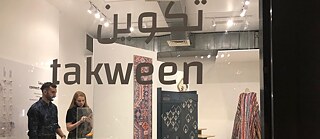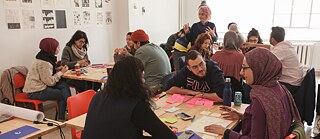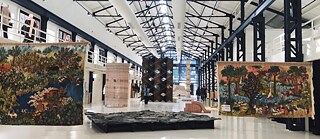“Takween” at Amman Design Week
Creation, formation, development

Amman Design Week took place in Jordan from October 4 to 12. “Takween”, a programme initiated by the design collective platform and the Goethe-Institut Jordan was also part of the meeting of creative professionals from all over the Middle East.
By Cornelia Wegerhoff
Designer Yacob Sughair spent weeks fine-tuning his work. Now his idea is going into production. “This is where a table from my new collection is being made,” explains the Jordanian as a saw hums in the background. “After cutting, the individual elements are assembled, glued and mortised.”
Yacob Sughair is standing in his own carpentry shop. His motto is that Jordanian design should create Jordanian jobs. And his latest collection shows his connections to his homeland. The glossy, anthracite-coloured tables, for example, are cut in functional, clean lines, but the tabletops are decorated with ancient Middle Eastern patterns.
“These pieces of furniture are reminiscent of the Sassanid epoch, an ancient Persian empire from about 250 to 600 AD,” says Sughair. “I used decorative elements they used to weave their carpets. This design is meant to build a bridge to our cultural heritage, to the people who live in the deserts and small villages in the Middle East.”

Takween means “formation”
Yacob Sughair also presented parts of his collection at Amman Design Week in a pop-up exhibition by the Goethe-Institut. Together with Amman Design Week, the German cultural institute wants to support the young Jordanian creative industry with “Takween”.
The Arabic word means “creation, formation, development,” explains Laura Hartz, the director of the Goethe-Institut in Amman. She is presently visiting the co-working space, which opened in the spring near Amman’s Old Town. Here, designers are specifically encouraged, she explains, “On the one hand through an intensive learning programme, but also with this creative space where we now are, a place that will become a networking place for the various interests and needs of the design industry.”
Bedouin clothing and space suits
The walls in the conference room are covered in sketches and notes. Fifteen designers are presently participating in a training programme here. The idea is not just to encourage their artistic work, but also, for example, to help them create a business plan in order to become commercially successful. Four Jordanians, including furniture designer Yacob Sughair, even received residency scholarships.
At 48, he is the oldest in the group, but sharing with his young colleagues also advances his work, he explains. “Being part of ,Takween’ gives me a new perspective on my work. Especially because we are forming a network.”
This network even includes Jordanian royalty. Queen Rania is the patron of Amman Design Week and is involved in Jordanian design projects throughout the year. At the end of August she was a guest at ,Takween’. Zeid Hijazi was also able to present his designs to the queen. The 22-year-old is a fashion designer, already studied in London, but has come back to Amman. He wants to be international, but he also wants to contribute his cultural identity. “I think we should be proud of our heritage, but we should take it and play with it,” he says. “For example, I studied Bedouin clothes. They wear these roomy jackets. Sometimes I think the Bedouins would rather escape this modern world. That’s why I combined space suits and Bedouin clothing in my latest designs.”

Shoes to ensure a future
The line of shoes that Farah Ajlouni, also a scholarship holder of the German-Jordanian “Takween” project, launched on the market is more down-to-earth – in the truest sense of the word. She’s actually a journalist, not a designer. “Through my work as a journalist, I often go to the refugee camps here in Jordan to report on the situation there. I’ve found that many of the people forced to live there have great talents but don’t know how to use them to earn money. I wanted to help them create a platform to sell their shoes.”
The very first collection was a success: colourful, light slip-ons with the traditional embroidery of the Syrian refugee women. “We had more demand than goods. We just released the new collection; the quality is always improving. The experience I’m gaining with ,Takween’ is now helping us manage larger volumes and we’re learning how to create even better networks.”
This article is an abridged version of a radio report broadcast by the “Fazit” programme on Deutschlandfunk Kultur on 7 October.